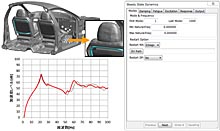A lot of features have been introduced to the multiphysics solvers of LS-DYNA since they were released 3 years ago. Electromagnetic solver (EM) now has mainly 2 new features recently. One is an axisymetric solver, which is much faster than before and supports MPP. The other one is battery modeling, which uses so called "1st order Randle circuits". One of the applications is to simulate the battery abuse case. On the other hand, CESE which hundles a compressible fluid from subsonic region to hypersonic one with density change supported not only the functions of thermal-fluid structure interaction(FSI), but also the functions of FSI including chemical reaction in latest version. And, chemistry solver supported a new modeling for hybrid inflator of airbag. We will introduce about new features of EM and CESE.
Resistance spot welding(RSW) is superior connecting methods about cost and work time compared to other methods , and applied to many products. Since LS-DYNA is implemented electromagnetic(EM) solver from R7 , resistive heating analysis is avalable. In this poster, we introduce the nugget generation simulation using EM solver and cooling simulation considering a phase transformarion .
JSOL provides various solutions of resin composite materials analysis, such as process chain simulation considering molding process, and material properties prediction considering micro structure. Here we will mainly introduce examples of software application focused on discontinuous fiber reinforced plastic.
Nowaday, domestic and oversea company has been using frequency domain function with LS-DYNA and some new features has been implemented. We will introduce latest work with frequency domain. The contents is as below.

TBA
The latest LS-DYNA provides collision, structure, thermal, fluid, electromagnetic and acoustic as the field. And, it has FEM, ICFD, EM, CESE, ALE, DEM, BEM, SPH, SPG, EFG as the feature. Most of these features can interact with each other. In this presentation, procedures such as which method to choose, how to setup the data, how to evaluate the result, will be shown with some applications.
ALE (Arbitrary Lagrangian and Eularian) method has been widely used for Fluid-Structure coupling analysis. Recently Structured-ALE (S-ALE) solver, which is more optimized and accelerates calculation speed, is been developed. The S-ALE solver enables us to apply FSI in new fields. We would talk about how to use LS-DYNA KEYWORD regarding S-ALE solver and comparison between ALE and S-ALE.
In Today's CAE, It has increased the opportunity to deal with a serious problems or multiphysics fields along with the advancement of CAE modeling. Therefore, LS-DYNA had responded to meshfree method such as EFG or SPH quickly, as a solution to strongly non-linear problems which occurs mesh distortion by large deformation with conventional finite element or difficulty fluid-structure interaction problems. LS-DYNA offeres the wide range of choices for problems solving by the corresponding to Discrete Element Method(DEM) from R6 and Smoothed Particle Galerkin Method(SPG) which is a proprietary technique of LS-DYNA from R8. In this presentation, we'll introduce the summary of meshfree method in LS-DYNA or use of guidelines of each methods and application examples.
The choice of the element type is the key to obtain a reasonable result from the simulation. Recently LS-DYNA has expanded its range of application by implementing various new element types including high-order elements. This allows users employ elements suitable for each simulation. However, it may cause possible incorrect choice of elements which leads to unexpected results. This session describes summary and characteristics of different elements available in LS-DYNA to perform simulations with well-chosen elements, along with the typical problems arise from wrongly-chosen elements and remedies for the problems. Example situations and applications of element in the actual simulation will also be introduced.
Recently, use of aluminum and plastics has increased in order to reduce weight of the vehicles, and the use of adhesive bonding has also increased to join different materials. In this presentation, we will introduce the modeling method of adhesive bonding in LS-DYNA. In addition, we will introduce a MDO (Multi-disciplinary Design Optimization) example about a crash box with adhesive bonds using LS-OPT.
In recent years, light weight design has been required especially in automotive industry in order to meet strict safety and fuel emission standard as well as riding comfort and maneuverability. In order to achieve the requirements above, well balanced product design is one of the key factors, and taking into account influence from scatter in production (material, forming, assembly) and scatter in operation (operation condition and environment). In general, study with computer simulation is conducted in deterministic manner. However, LS-DYNA has a feature to generate model with scatter in geometry and material properties and enables conducting stochastic studies by running these models multiple times. In this session, stochastic features in LS-DYNA are introduced with examples.